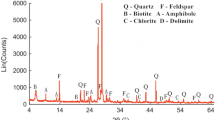Abstract
The alteration of magnetic minerals taking place during the investigation of the temperature variation of bulk magnetic susceptibility is obvious from different courses of heating and cooling susceptibility vs. temperature curves. A set of indices is introduced to characterize these changes numerically. The A 40 alteration index characterizes the change in susceptibility after executing the whole cycle of heating and cooling. The maximum difference between the heating and cooling curves is characterized by the A max alteration index. The mean or average difference between the heating and cooling curves is characterized by the A m alteration index. The situation whether the heating and cooling curves cross, is characterized by the A cr alteration index. The technique of progressive repeated heating is proposed, together with the above indices, to locate the temperature intervals with weak and strong magnetic mineral changes induced by heating.
Similar content being viewed by others
References
Appel E. and Soffel H.C., 1985. Domain state of Ti-rich titanomagnetites deduced from domain structure observations and susceptibility measurements. J. Geophys., 56, 121–132.
Böhnel H., Morales J., Caballero C., Alva L., McIntosh G., Gonzales S. and Sherwood G.J., 1997. Variation of rock magnetic parameters and paleointensities over a single Holocene lava flow. J. Geomag. Geoelectr., 49, 523–542.
Böhnel H., McIntosh G., Sherwood G. and Moores J., 2002. A parameter characterising the irreversibilitry of thermomagnetic curves. Phys. Chem. Earth, 27, 1305–1309.
Borradaile G.J. and Lagroix F., 2000. Thermal enhancement of magnetic fabrics in high grade gneisses. Geophys. Res. Lett., 27, 2416–2416.
Coe R.S., 1967. The determination of paleointensities of the Earth's magnetic field with emphasis on mechanisms which could cause non-ideal behavior in Thellier's method. J. Geomag. Geoelectr., 19, 157–179.
Henry B., Jordanova D., Jordanova N., Souque C. and Robion P., 2003. Anisotropy of magnetic susceptibility of heated rocks. Tectonophysics, 366, 241–258.
Hirt A. and Gehring A., 1991. Thermal alteration of the magnetic mineralogy in ferruginous rocks. J. Geophys. Res., 96, 9947–9954.
Hrouda F., 1994. A technique for the measurement of thermal changes of magnetic susceptibility of weakly magnetic rocks by the CS-2 apparatus and KLY-2 Kappabridge. Geophys. J. Int., 118, 604–612
Hrouda F., Jelínek V. and Zapletal K., 1997. Refined technique for susceptibility resolution into ferromagnetic and paramagnetic components based on susceptibility temperature-variation measurement. Geophys. J. Int., 129, 715–719.
Hrouda F., Chlupácová M. and Novák J.K., 2002. Variations in magnetic anisotropy and opaque mineralogy along a kilometer deep profile within a vertical dyke of the syenogranite porphyry at Cínovec (Czech Republic). J. Volcanol. Geotherm. Res., 2359, 1–12.
Kropácek V. and Pokorná Z., 1973. Magnetische Eigenschaften basischer neovulkanischer Gesteine der Boehmischen Masse und ihre Zusammenhaenge mit petrologischen Charakteristiken. Geof. sbornik, 21, 287–348.
Kropácek V., 1976. Changes of the magnetic properties of Tertiary alkaline basalts under oxidation of titanomagnetites. Publs. Inst. Geoph. Pol. Ac. Sci., C-1 (102), 75–85.
Mintsa Mi Nguema T., Trindade R.I.F., Bouchez J.L. and Launeau, P., 2002. Selective thermal enhancement of magnetic fabrics from the Carnmenellis granite (British Cornwall). Phys. Chem. Earth, 27, 1281–1287.
Nell J. and den Hoed P., 1997. Separation of chromium oxides from ilmenite by roasting and increasing the magnetic susceptibility of Fe2O3-FeTiO3 (ilmenite) solid solution. Heavy Minerals, 1997, 75–78.
Perarnau A. and Tarling D.H., 1985. Thermal enhancement of magnetic fabric in Cretaceous sandstones. J. Geol. Soc. London, 142, 1029–1034.
Schultz-Krutisch T. and Heller F., 1985. Measurement of magnetic susceptibility anisotropy in Buntsandstein deposits from southern Germany. J. Geophys., 56, 51–58.
Sherwood G.J., Shaw J., Baer G. and Basu Mallik S., 1993. The strength of the geomagnetic field during the Cretaceous Quiet Zone: paleointensity results from Israeli and Indian Lavas. J. Geomag. Geoelectr., 45, 339–360.
Urrutia-Fucugauchi J., 1981. Preliminary results on the effects of heating on the magnetic susceptibility anisotropy of rocks. J. Geomag. Geoelectr., 33, 411–419.
Author information
Authors and Affiliations
Rights and permissions
About this article
Cite this article
Hrouda, F. Indices for Numerical Characterization of the Alteration Processes of Magnetic Minerals Taking Place During Investigation of Temperature Variation of Magnetic Susceptibility. Studia Geophysica et Geodaetica 47, 847–861 (2003). https://doi.org/10.1023/A:1026398920172
Published:
Issue Date:
DOI: https://doi.org/10.1023/A:1026398920172




